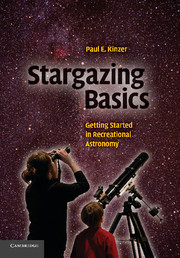Book contents
- Frontmatter
- Contents
- Acknowledgements
- Introduction: why another stargazing guide?
- Part I Stargazing techniques and equipment
- 1 With the naked eye alone
- 2 Binoculars: the next step
- 3 “But I want a telescope!”
- Part II What's up there?
- Part III A stargazing glossary
- Appendix 1 the Greek alphabet
- Appendix 2 the constellations
- Some simple star charts
- Index
2 - Binoculars: the next step
Published online by Cambridge University Press: 12 August 2009
- Frontmatter
- Contents
- Acknowledgements
- Introduction: why another stargazing guide?
- Part I Stargazing techniques and equipment
- 1 With the naked eye alone
- 2 Binoculars: the next step
- 3 “But I want a telescope!”
- Part II What's up there?
- Part III A stargazing glossary
- Appendix 1 the Greek alphabet
- Appendix 2 the constellations
- Some simple star charts
- Index
Summary
The human eye, under truly dark skies, can see a few thousand stars. We can see so many because, where there is no artificial light to interfere, the eye's iris contracts to its smallest size, allowing the pupil to open to its widest diameter. This allows the maximum amount of light to enter and shine upon the retina, the light-gathering area in the back of the eye.
Yet why do we only see a few thousand stars, when there are hundreds of billions in our own galaxy, and billions of galaxies? Because the human eye's pupil can only open to a diameter of about seven millimeters (a little more than a quarter inch). As we get older, this usually decreases to about five millimeters (about a fifth of an inch).
Why is this important? Because, contrary to what most people think, it is this small opening that primarily determines how much we can see in the night sky, not magnification. Most stars and other objects are simply too dim to be seen by the human eye. A larger aperture (usually expressed as the diameter of a light-gathering surface, but actually its area) is the key thing, for two reasons: it allows dimmer objects to be seen by gathering more light over a wider area, and it also causes objects to be seen more clearly (see More info – Comparing apertures, on page 20). The first seems obvious, the second less so; but both are true.
- Type
- Chapter
- Information
- Stargazing BasicsGetting Started in Recreational Astronomy, pp. 17 - 26Publisher: Cambridge University PressPrint publication year: 2008
- 1
- Cited by



